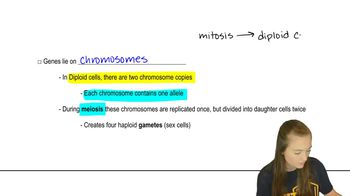Here are the essential concepts you must grasp in order to answer the question correctly.
Diploid Number
The diploid number (2n) refers to the total number of chromosomes in a somatic cell, which in this case is 36 for the animal Geneticus introductus. This means that there are 18 pairs of homologous chromosomes, with one set inherited from each parent. Understanding the diploid number is crucial for determining the genetic content of the organism.
Recommended video:
DNA Replication
DNA replication is the process by which a cell duplicates its DNA before cell division. During the S phase of the cell cycle, each chromosome is replicated, resulting in two sister chromatids for each chromosome. This means that the total amount of DNA in the nucleus doubles, which is essential for ensuring that each daughter cell receives an identical set of chromosomes.
Recommended video:
S Phase
The S phase, or synthesis phase, is a part of the cell cycle where DNA replication occurs. It follows the G₁ phase and precedes the G₂ phase. During this phase, the amount of DNA in the nucleus increases as each chromosome is copied, leading to a temporary state where the amount of DNA is twice that of the G₁ phase, which is critical for proper cell division.
Recommended video:
 Verified step by step guidance
Verified step by step guidance Verified video answer for a similar problem:
Verified video answer for a similar problem:

